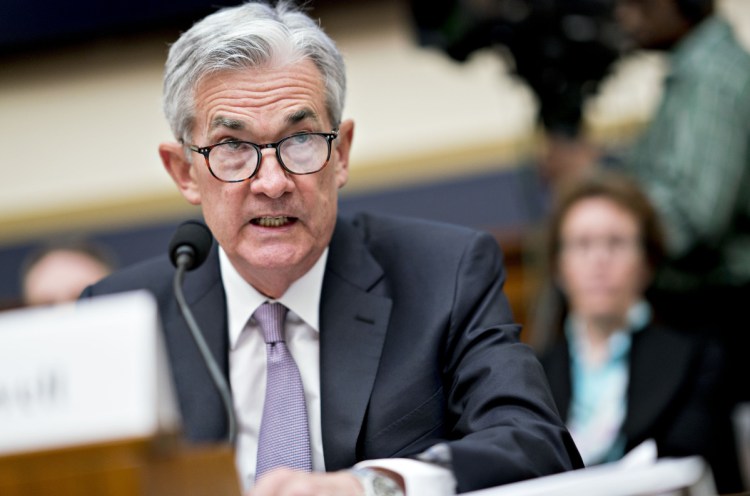WASHINGTON — Jerome Powell, the new chairman of the Federal Reserve, made his debut public appearance Tuesday, where he told the House Financial Services Committee that he is committed to “clearly explaining” Fed thinking and that the U.S. economy is getting better. He said the recent stock market jitters don’t worry him and he reiterated that the Fed intends to raise interest rates at a slow and steady pace – similar to its moves under his predecessor, Janet Yellen.
“My personal outlook for the economy has strengthened since December,” Powell said, adding that he has little concern about a recession any time soon. “I don’t see (the recession risks) as at all high at the moment.”
In December, the Fed predicted the U.S. economy would grow at a 2.5 percent pace this year. Since then, President Trump’s tax cuts passed and Congress agreed to raise federal spending by about half a trillion dollars. Powell didn’t give a firm growth estimate Tuesday, but he sounded upbeat and he noted that the economy grew at “about 3 percent” in the second half of 2017, which is Trump’s goal.
Powell has one of the more difficult jobs in Washington right now. He has to keep Wall Street calm, unemployment low and inflation in check – all while facing pressure from President Trump.
While the Fed is an independent entity over which Trump has no direct control, Powell is a Trump nominee, and the president has made it clear he wants faster economic growth and a booming stock market.
On Tuesday, Republican lawmakers repeatedly tried to get Powell to say the tax cuts are boosting wages, but Powell refused to admit that. Democrats then tried to get him to say the cuts are adding to the debt and benefit only Wall Street shareholders, which Powell also dodged weighing in on. He stressed that the goal of the most sweeping tax legislation in more than 30 years is to get businesses to invest more and that it’s too early to tell whether that’s happening.
“The next couple of years look quite strong. I would expect the next two years to be good years for the economy,” Powell said. But he hedged that higher wages would only come “over time” if corporations invest more in factories, new equipment and better technology to make workers more productive.
The Fed chair tried to reassure America that he can walk that line between letting growth pick up after the Trump tax cuts, but not letting the economy get so hot that there’s danger of a crash.
The Fed “will continue to strike a balance between avoiding an overheated economy and bringing PCE price inflation to 2 percent on a sustain basis,” Powell said. “Further gradual increases in the federal funds rate will best promote attainment of both of our objectives.”
His comments suggest that he still thinks the Fed should boost interest rates three times in 2018, although he sounded upbeat about the economy, opening the door to possibly doing more increases.
Wall Street traders and economists are overwhelmingly predicting a rate hike at the Fed’s next meeting on March 21.
By raising interest rates, the Fed looks to cool the economy and ward off inflation, and investors are listening carefully for any signs that Powell intends to pick up the pace of rate hikes.
There’s a growing worry that the economy could overheat after the tax cuts and the massive increase in government spending that Congress just approved. Billionaire hedge fund manager Ray Dalio, who correctly predicted the financial crisis, now sees a 70 percent chance of a recession before the 2020 presidential election.
“Powell’s going to err on the side of caution,” said Joseph LaVorgna, chief economist at investment bank Natixis. “It would be a mistake to hint at four rates hikes this year. If the Fed did four hikes, the yield curve would likely invert, and that would send an ominous sign.”
Fears of the economy and inflation getting out of control triggered the stock market sell-off in early February.
The Dow fell an ominous 666 points on the final day of former Fed chair Yellen’s tenure, and it sunk nearly 1,200 points – the biggest single day point drop in market history – on Powell’s first official day on Feb. 5. But it has since regained most of the losses.
Copy the Story LinkSend questions/comments to the editors.



Success. Please wait for the page to reload. If the page does not reload within 5 seconds, please refresh the page.
Enter your email and password to access comments.
Hi, to comment on stories you must . This profile is in addition to your subscription and website login.
Already have a commenting profile? .
Invalid username/password.
Please check your email to confirm and complete your registration.
Only subscribers are eligible to post comments. Please subscribe or login first for digital access. Here’s why.
Use the form below to reset your password. When you've submitted your account email, we will send an email with a reset code.